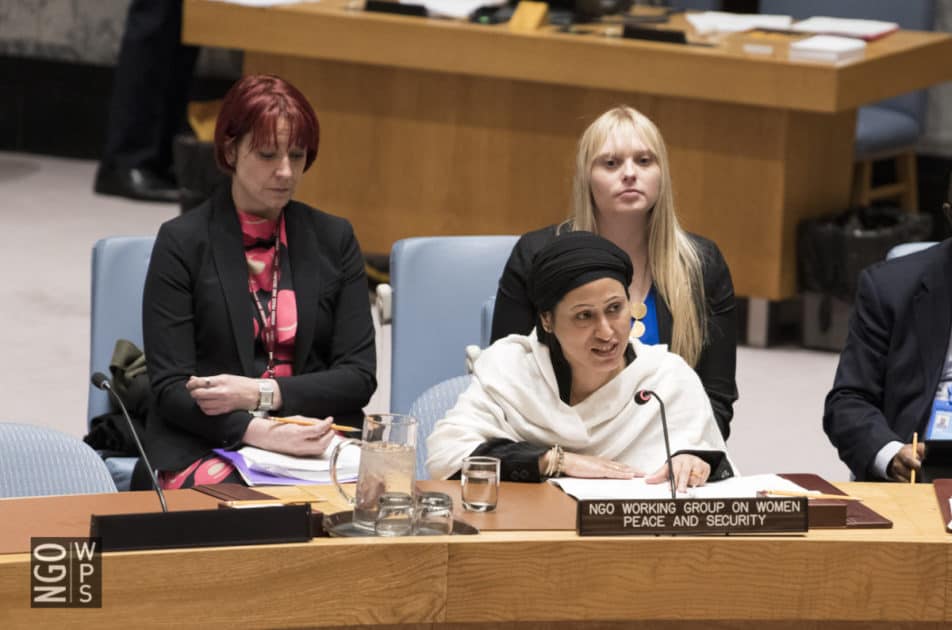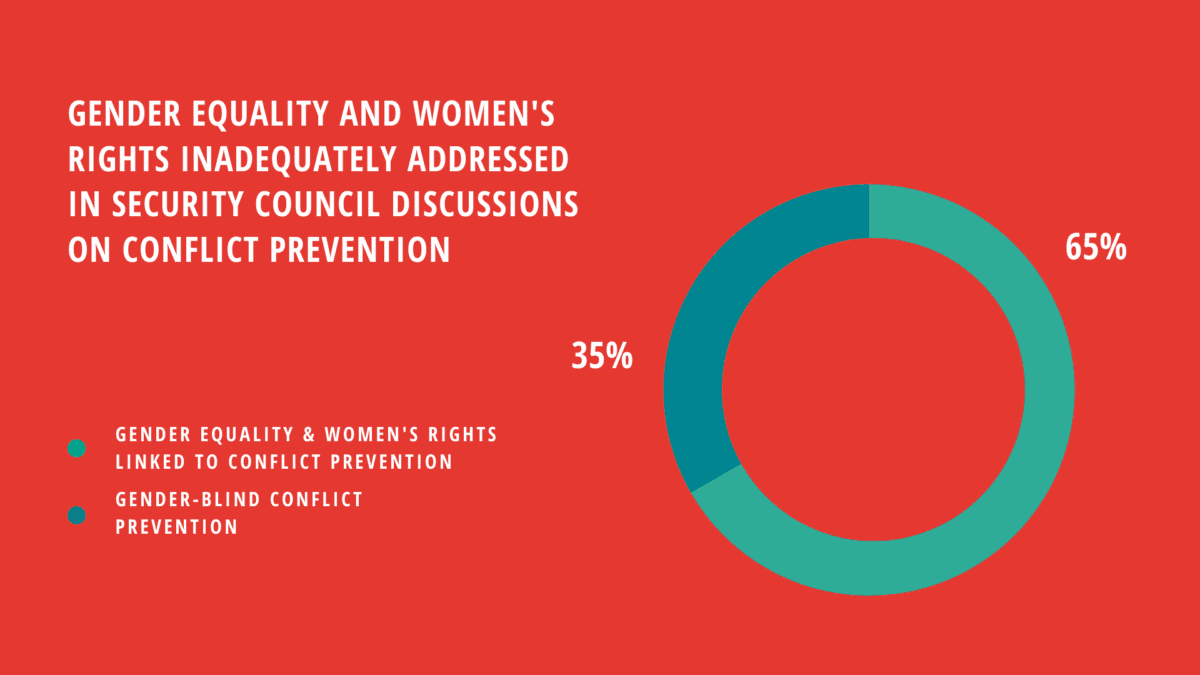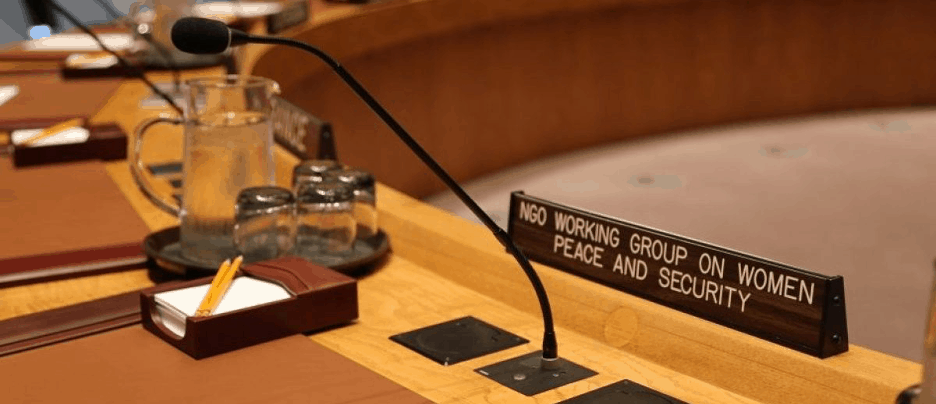Prevention of Conflict
“It is hypocritical to condemn human rights violations and express horror at the new violence, while then also selling arms to Myanmar and seeking explorative licenses to mine its natural resources. Member States committed to conflict prevention and sustaining peace cannot turn a blind eye to state-sanctioned ethnic minority persecution, discrimination or other human rights violations, including sexual violence, for trade.”
Razia Sultana, UN Security Council Open Debate on Sexual Violence in Conflict, April 2018

Key Messages
Preventing conflict and sustaining peace are not simply matters of ending war and violence – they must address the root causes of conflict. Addressing securitization and militarization, arms proliferation and the political economy of war; protection, fulfillment and promotion of human rights, including gender equality and women’s human rights; justice, accountability and the rule of law; inclusive sustainable development, and ensuring a free and open civil society must be core objectives of any action taken to address country-specific crisis situations.
As enshrined in the UN Charter, it is the primary responsibility of the Security Council to maintain peace and security – this includes taking decisive action to prevent conflict and avert crises. Security Council members should support timely and decisive action aimed at protection of civilians, and preventing or ending the commission of genocide, crimes against humanity and war crimes, in accordance with international law.
Gender equality and women’s human rights are essential in all conflict-affected situations, and violation of these rights is both a root cause and an early warning sign of conflict. The Global Study on the Implementation of Security Council 1325 (2000) emphasized the need for the WPS agenda to be viewed both as a peace and security issue and a critical part of the human rights agenda. It highlighted women’s human rights and gender equality as central to the maintenance of international peace and security, and that they are the responsibility of all intergovernmental bodies, including the Security Council. The Security Council must reaffirm human rights, including the rights of all women and girls, and of those most marginalized, as central to all conflict prevention efforts in order to fulfill its responsibility to maintain international peace and security.[1] Women’s “empowerment” and other human rights issues must not be instrumentalized to advance geopolitical interests or to justify militarized approaches to resolving conflict.
In addition, threats and violence against activists, including women human rights defenders, must be treated as an early warning sign of escalating conflict or instability. Threats and reprisals against civil society activists can be early warning signs of instability. In 2019, women human rights defenders and activists in Brazil, Chile, Honduras, Iraq, the Philippines, Sudan, Nigeria and Uganda were killed or attacked;[2] this violence coincided with increased repression of human rights and violence within each of these countries.[3] Increased targeting of human rights defenders, who are a critical source of information regarding emerging human rights emergencies, can be an important indicator of potential conflict as it indicates a desire by governments to prevent information regarding the situation at the local level from reaching the international community.[4] Member States must not repress human rights defenders, and provide financial, political and other forms of support to foster non-discriminatory and open space for civil society, including for women and other marginalized groups, to enable local leadership and to bolster their capacity to contribute to building peace.
Facts

Why is gender equality essential for preventing conflict and building peace?
- As outlined in the 2030 Agenda, gender equality and protecting and promoting women’s rights are fundamental principles underpinning sustainable peace.[5] Sustainable Development Goals 5, 10, and 16 are closely interlinked and intertwined, reinforcing the inter-related nature of addressing inequality, dismantling discrimination and fostering peace.[6]
- Inequality, exclusion and concentration of power and wealth, are root causes of conflict and violence; yet over the last thirty years, inequality within countries has increased and progress in advancing women’s rights and gender equality has stalled or even regressed.[7]
- There is clear evidence showing that gender inequality is a key predictor of the occurrence and recurrence of armed conflict.[8] In countries that have lower levels of violence against women, higher labor market participation of women, and fewer income disparities, interstate or internal conflict is far less likely to be initiated.[9]
- Social and political inclusion is central to fostering more peaceful societies; this cannot be done without eliminating discriminatory laws and ensuring the participation of all members of society, including women, which has been shown to be an important aspect of building peace.[10]
- Undermining and eroding women’s economic and social rights, including restrictions on women’s participation in the economy, right to inheritance and property, and financial exclusion, worsens income inequality and overall outcomes for families and communities, and contributes to the root causes of conflict and war.[11]
Source: Pathways for Peace: Inclusive Approaches to Preventing Violent Conflict
Recommendations
- Require gender-sensitive conflict analysis and an analysis of root causes of conflict in all UN programming and decision-making, including conflict prevention, humanitarian programming, preventing violent extremism, peacebuilding, peacekeeping and development efforts. All UN entities, including the Department of Peace Operations (DPO), the Department of Political and Peacebuilding Affairs (DPPA), the Office for the Coordination of Humanitarian Affairs (OCHA) and the United Nations Development Programme (UNDP), must ensure that all gender-sensitive conflict analysis meets certain minimum standards, which reflect existing standard operating procedures, policies and commitments.[12] Such analysis must be translated into gender-sensitive programming, inform humanitarian needs assessments, and be included in all country- and region-specific reports of the Secretary-General and briefings delivered by senior UN officials. All conflict analysis must include a robust, intersectional discussion of gender, including gender norms, sexual orientation and gender identity, take into account diverse ethnic, cultural and religious identities, and be grounded in sex-, disability- and age-disaggregated data. As part of carrying out gender-sensitive conflict analysis efforts, and in order to ensure all programming is reflective of local realities, all UN entities, including DPO, DPPA, OCHA, UNDP and the Office of the High Commissioner for Human Rights (OHCHR), must be required to regularly and meaningfully engage with women’s civil society organizations, activists, peacebuilders and human rights defenders through all stages of such processes.[13]
- Require all senior officials across all UN entities to uphold gender equality and human rights as a fundamental part of their prevention mandate, including in public statements and policy frameworks. Given the primacy of conflict prevention in the mandate of the UN, senior officials, including the Secretary-General, should regularly and publicly champion gender equality, call for the promotion of all human rights, including comprehensive sexual and reproductive health and rights (SRHR), in all efforts to prevent conflict at all levels, and call out governments that undermine these rights. Senior officials must consistently emphasize gender equality, human rights and the political primacy of women’s full, equal and meaningful participation across all peace and political processes, in all discussions with government officials, and further reinforce their necessity in establishing and strengthening institutions, legislation and policies. This should also be reflected in all internal planning and policy frameworks, including in the areas of sustainable development, humanitarian action and peacebuilding.
- Invest in early warning systems that are gender-responsive, disability-accessible and inclusive to avert crises and prevent conflict. Programming and decision-making processes, including within the Security Council, must be informed by regular assessment of early warning indicators that are context-specific, gender-sensitive, disability-accessible, evidence-based and developed in partnership with local communities.
- Defend the centrality of gender equality and the full scope of human rights of all women and girls in all international peace and security processes and all outcome documents. This includes calling for gender equality and human rights to be at the center of negotiations in the context of all peace processes. This also requires including specific provisions in the mandates of all peace operations that call on them, along with UN Country Teams, to monitor and report on violations and abuses of human rights, including violations of all women’s human rights in line with the Convention on the Elimination of All Forms of Discrimination Against Women (CEDAW). In addition, this should also require both peace operations and Country Teams to consult with women’s civil society organizations as part of their mandate to protect and promote human rights.
- The Security Council has the primary responsibility to maintain international peace and security. Its members should support timely and decisive action aimed at preventing or ending the commission of genocide, crimes against humanity or war crimes. They should publicly pledge not to vote against a credible draft resolution before the Security Council aimed at halting or preventing such crimes, in line with the Accountability Coherence and Transparency Group’s Code of Conduct (A/70/621)[14]. Relatedly, members of the Security Council and Member States must not enable arms transfers when there is a substantial risk that they may be used to “commit or facilitate serious acts of gender-based violence or serious acts of violence against women and children,” in line with the Arms Trade Treaty (ATT). Members States must also intensify efforts towards reducing the flow of small arms and light weapons (SALW) by implementing all relevant treaties and protocols, including the ATT, Protocol against the Illicit Manufacturing of and Trafficking in Firearms, Their Parts and Components and Ammunition (A/RES/55/255), and the Programme of Action to Prevent, Combat and Eradicate the Illicit Trade in Small Arms and Light Weapons in All Its Aspects (UN PoA).[15]
- Respect, protect and fulfill all obligations under international humanitarian and human rights law, unequivocally condemn any violations, including abuses targeting women and girls, by all parties to armed conflict, and ensure accountability of perpetrators. This should include consistently condemning direct and indiscriminate attacks on civilians, deliberate targeting of schools, hospitals or other civilian infrastructure, denial of sexual and reproductive health services, and arbitrary denial of humanitarian access, all of which undermine women’s human rights. Ensure that there are consequences for state and non-state actors who deliberately violate or disregard international obligations, including through accountability mechanisms. Consistently support the creation of international, independent investigative mechanisms in situations of armed conflict. Commit to making the reports of such mechanisms public to bring greater transparency to the Security Council’s work in pursuit of accountability for grave violations and to deter future violations. Encourage parties to armed conflict to decisively and transparently investigate allegations of civilian harm committed by their forces.[16]
- Center deliberations and decision-making regarding the formation, review and drawdown of peace operations on long-term approaches to sustaining peace, including gender-sensitive analysis of the root causes of conflict. Center deliberations and decision-making regarding the formation, review and drawdown of peace operations on long-term approaches to sustaining peace, including gender-sensitive analysis of the root causes of conflict, in line with Resolution 2282 (2016). This entails the inclusion of provisions related to gender-responsive early warning and peacebuilding in the mandates of peace operations, and ensuring that capacity for gender-responsive peacebuilding is prioritized during any transition. In this respect, the Security Council should regularly request, deliberate and draw upon the specific advice of the Peacebuilding Commission and ensure complementarity of efforts.
- Intensify efforts to employ gender-sensitive small arms control as part of arms embargoes to safeguard against proliferation and diversion. Explicitly call for all associated expert groups to carry out intersectional gender-sensitive analysis of the role that small arms play in exacerbating conflict and undermining peace and security, and call for detailed information related to arms transfers that violate the ATT and thus contribute to violations of international humanitarian law, including gender-based violence.
- Require rights-based and age-, gender- and disability-sensitive pandemic responses: COVID-19 responses must be grounded in data disaggregated by gender, age and disability, and intersectional analysis that recognizes the gendered impact of the crisis. Where this data does not yet exist, the Security Council must request it to inform its own response to the pandemic.
- Protect civilians and ensure principled humanitarian access to all people in need: Demand cessation of attacks against civilians, healthcare workers and humanitarian actors, which violate international humanitarian, criminal and human rights law and Security Council Resolution 2286 (2016). Support the Secretary-General’s call that national authorities designate humanitarian workers as essential, given their direct and indispensable role in delivering life-saving assistance.
[1]UNGA & UNSC, Prevention of armed conflict (S/2001/574), 2001.
UNSC, Security and development (S/PRST/2015/3), 2015.
UNGA & UNSC, Sustaining peace (S/2018/43), 2018.
UNGA & UNSC, The challenge of sustaining peace: Report of the advisory group of experts for the 2015 review of the UN peacebuilding architecture (S/2015/490), 2015.
Coomaraswamy, Chapter 8: Preventing conflict: the origins of the women, peace and security agenda, Preventing Conflict, Transforming Justice, Securing the Peace: A Global Study on the Implementation of UN Security Council resolution 1325, 2015. https://wps.unwomen.org/pdf/CH08.pdf
Brethfeld & Wright, Conflict prevention is vital for women, peace and security, Saferworld, 2015. https://www.saferworld.org.uk/resources/news-and-analysis/post/151-conflict-prevention-is-vital-for-women-peace-and-security
[2]UN Human Rights Council, Practical recommendations for the creation and maintenance of a safe and enabling environment for civil society, based on good practices and lessons learned: Report of the United Nations High Commissioner for Human Rights, 2016. https://undocs.org/en/A/HRC/32/20
Front Line Defenders, Global Analysis 2019, 2019.
[3]Front Line Defenders, Global Analysis 2019, 2019. https://www.frontlinedefenders.org/sites/default/files/global_analysis_2019_web.pdf
[4]UN Human Rights Council, Overview of consultations on the contribution of the Human Rights Council to the prevention of human rights violations Report of the rapporteurs, 2020. https://undocs.org/en/A/HRC/43/37
[5]UN Women, Turning Promises into Action, 2018. https://www.unwomen.org/-/media/headquarters/attachments/sections/library/publications/2018/sdg-report-gender-equality-in-the-2030-agenda-for-sustainable-development-2018-en.pdf?la=en&vs=4332
[6]Tosun and Leininger, Governing the Interlinkages between the Sustainable Development Goals: Approaches to Attain Policy Integration, Global Challenges, 2017. https://onlinelibrary.wiley.com/doi/full/10.1002/gch2.201700036
Institute for Economics and Peace, Goal 16, 2017. http://visionofhumanity.org/app/uploads/2017/02/Goal16_2016_webfile.pdf
Institute for Economics and Peace, Global Peace Index 2020, 2020. http://visionofhumanity.org/app/uploads/2020/06/GPI_2020_web.pdf
Institute for Economics and Peace, Positive Peace Report 2019, 2019. http://visionofhumanity.org/app/uploads/2019/10/PPR-2019-web.pdf
United Nations, Plan of A
[7]Pathfinders for Peaceful, Just and Inclusive Societies, Challenge Paper: Inequality and Exclusion, 2019. https://cic.nyu.edu/sites/default/files/pathfinders-inequality-challenge-paper-updated-october.pdf
Klugman, What’s Good for Women and Girls can be Good for Men and Boys, 2019. https://cic.nyu.edu/sites/default/files/klugman_gender_inequality_june_2019_short_note_final_june_4.pdf
[8]Taylor and Lupel, In Peace and in War Gender Equality is Everyone’s Battle, 2018. https://theglobalobservatory.org/2018/12/in-peace-war-gender-equality-everyones-battle/
[9]Hudson, et. al., Sex and World Peace, 2012.
[10]World Bank, Pathways for Peace: Inclusive Approaches to Preventing Violent Conflict, 2018. https://openknowledge.worldbank.org/handle/10986/28337
Pathfinders, The Roadmap for Peaceful, Just and Inclusive Societies: A Call to Action to Change Our World, 2019. https://cic.nyu.edu/sites/default/files/roadmap_for_peaceful_just_and_inclusive_societies_9jul19_1-web_0.pdf
Caprioli and Tumbore, “Ethnic Discrimination and Interstate Violence: Testing the International Impact of Domestic Behavior, ” Journal of Peace Research, 2003.
Caprioli, et. al., “Putting Women in Their Place,” Baker Journal of Applied Public Policy, 2007.
Herbert, Links between Women’s Empowerment (or Lack of) and Outbreaks of Violent Conflict, 2017.
Hudson, et. al., “The Heart of the Matter: The Security of Women and the Security of States,” International Security, 2009.
[11]Klugman, What’s Good for Women and Girls can be Good for Men and Boys, 2019. https://cic.nyu.edu/sites/default/files/klugman_gender_inequality_june_2019_short_note_final_june_4.pdf
[12]UN, Directive of the Secretary-General on Planning, 2019.
Action for Peacekeeping: Declaration of Shared Commitments on UN Peacekeeping Operations, 2018. https://peacekeeping.un.org/sites/default/files/a4p-declaration-en.pdf
UN DPO, Policy: Gender Responsive UN Peacekeeping Operations,2018. https://peacekeeping.un.org/sites/default/files/gender-responsive-un-peacekeeping-operations-policy-en.pdf
UN DPO, Women transforming peace through peacekeeping, 2019. https://peacekeeping.un.org/sites/default/files/policy_brief.pdf
UN DPO, Gender Equality and Women, Peace and Security: Resource Package, 2019. https://peacekeeping.un.org/sites/default/files/gewps19_respack_v7_eng_digital.pdf
UN DPO, DPPA, OHCHR, OSRSG SVC, Policy: UNField Missions: Preventing and responding to Conflict-related Sexual Violence (2019.35), 2019. https://www.un.org/sexualviolenceinconflict/wp-content/uploads/2020/02/DPO-DPPA-SRSG-SVC-OHCHR-Policy-on-Field-Missions-Preventing-and-Responding-to-CRSV-2020.pdf
UN Security Council, Letter dated 28 October 2019 from the Chair of the Peacebuilding Commission addressed to the President of the Security Council (S/2019/845), 2019. https://undocs.org/S/2019/845
[13]Saferworld, WILPF & Oxfam, Building inclusive peace: Gender at the Heart of Conflict Analysis, 2017. https://wilpf.org/wp-content/uploads/2018/01/BuildingInclusivePeace-GenderHeartConflictAnalysis.pdf
Cordaid, Delivering SRHR Services in Fragile Contexts, 2017. https://www.cordaid.org/en/wp-content/uploads/sites/11/2018/01/Cordaid_Healthcare_-SRHR-programs_EN_June-2017_LR.pdf
[14]Joint Statement: 22 NGOs Call for Action to Strengthen the Protection of Civilians in Armed Conflict, 2019.
https://reliefweb.int/report/world/joint-statement-22-ngos-call-action-strengthen-protection-civilians-armed-conflict
[15]Gerome, Preventing Gender-Based Violence through Arms Control, 2016.
[16]Joint Statement: 22 NGOs Call for Action to Strengthen the Protection of Civilians in Armed Conflict, 2019.
